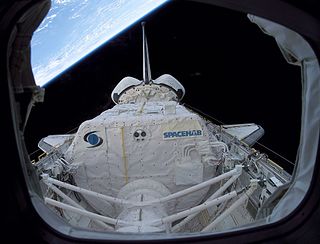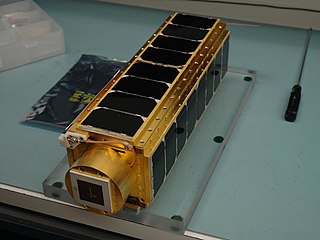The Fugro SpAARC Space Automation, Artificial Intelligence and Robotics Control (SpAARC) facility is a mission control center created by a collaboration between the Australian Space Agency, the government of Western Australia (WA) and the Dutch company Fugro. SpAARC provides telerobotic control for both spaceflight and terrestrial vehicles. SpAARC, opened in November 2020, is Fugro's largest remote operations center. [1] SpAARC is located in Perth, Australia.
Fugro SpAARC was selected as the contingency control center for the Intuitive Machines Nova-C IM-1 lunar landing mission. [2]

Skylab was the United States' first space station, launched by NASA, occupied for about 24 weeks between May 1973 and February 1974. It was operated by three trios of astronaut crews: Skylab 2, Skylab 3, and Skylab 4. Operations included an orbital workshop, a solar observatory, Earth observation and hundreds of experiments. Skylab's orbit eventually decayed and it disintegrated in the atmosphere on July 11, 1979, scattering debris across the Indian Ocean and Western Australia.

STS-107 was the 113th flight of the Space Shuttle program, and the 28th and final flight of Space Shuttle Columbia. The mission ended on February 1, 2003, with the Space Shuttle Columbia disaster which killed all seven crew members and destroyed the space shuttle. It was the 88th post-Challenger disaster mission.

The Lyndon B. Johnson Space Center (JSC) is NASA's center for human spaceflight in Houston, Texas, where human spaceflight training, research, and flight control are conducted. It was renamed in honor of the late US president and Texas native, Lyndon B. Johnson, by an act of the United States Senate on February 19, 1973.

STS-61-A was the 22nd mission of NASA's Space Shuttle program. It was a scientific Spacelab mission, funded and directed by West Germany – hence the non-NASA designation of D-1. STS-61-A was the ninth and last successful flight of Space Shuttle Challenger before the disaster. STS-61-A holds the current record for the largest crew—eight people—aboard any single spacecraft for the entire period from launch to landing.

STS-67 was a human spaceflight mission using Space ShuttleEndeavour that launched from Kennedy Space Center, Florida on March 2, 1995.

The following outline is provided as an overview of and topical guide to space exploration.

Fugro NV is a Dutch multinational public company headquartered in Leidschendam, Netherlands. The company is primarily a service company focused on geotechnical, survey and geoscience services, and is listed on Euronext Amsterdam. Mark Heine is Fugro's CEO and Chairman of the Board of Management, while Harrie L.J. Noy is Chairman of the Supervisory Board.

PharmaSat Risk Evaluation Satellite nanosatellite, for NASA, was about the size of a loaf of bread, weighed about 4.5 kg (9.9 lb) and was constructed in just six months.

ArgoMoon is a CubeSat that was launched into a heliocentric orbit on Artemis 1, the maiden flight of the Space Launch System, on 16 November 2022 at 06:47:44 UTC. The objective of the ArgoMoon spacecraft is to take detailed images of the Interim Cryogenic Propulsion Stage following Orion separation, an operation that will demonstrate the ability of a cubesat to conduct precise proximity maneuvers in deep space. ASI has not confirmed nor denied whether this took place, but several images of the Earth and the Moon were taken.
The International Lunar Observatory (ILO) is a private scientific and commercial lunar mission by the International Lunar Observatory Association of Kamuela, Hawaii to place a permanent observatory near the South Pole of the Moon to conduct astrophysical studies using an optical telescope and possibly an antenna dish. The mission aims to prove a conceptual design for a lunar observatory that would be reliable, low cost, and fast to implement. A precursor mission, ILO-X consisting of two small imagers, launched on 15 February 2024 aboard the Intuitive Machines IM-1 mission to the Moon south pole region. It is hoped to be a technology precursor to a future observatories on the Moon, and other commercial initiatives.

The Australian Space Agency is an agency under the Australian Government responsible for the development of Australia's commercial space industry, coordinating domestic activities, identifying opportunities and facilitating international space engagement that include Australian stakeholders.

The Intuitive Machines Nova-C, or simply Nova-C, is a class of lunar landers designed by Intuitive Machines (IM) to deliver small payloads to the surface of the Moon. Intuitive Machines was one of three service providers awarded task orders in 2019 for delivery of NASA science payloads to the Moon. The IM-1 lunar lander, named Odysseus, was launched by a SpaceX Falcon 9 rocket on 15 February 2024, reached lunar orbit on 21 February, and landed on the lunar surface on 22 February. This marked the inaugural Nova-C landing on the Moon and the first American spacecraft to perform a soft landing on the Moon in over 50 years. It is the first spacecraft to use methalox propulsion to navigate between the Earth and the Moon.

Intuitive Machines, Inc. is an American space exploration company headquartered in Houston, Texas. It was founded in 2013 by Stephen Altemus, Kam Ghaffarian, and Tim Crain, to provide lunar surface access, lunar orbit delivery, and communication from lunar distance. Intuitive Machines holds three NASA contracts under the space agency's Commercial Lunar Payload Services (CLPS) initiative, to deliver payloads to the lunar surface.Among these, the company holds a contract to develop a Lunar Terrain Vehicle (LTV).

SpaceX CRS-23, also known as SpX-23, was a Commercial Resupply Service mission to the International Space Station, successfully launched on 29 August 2021 and docking the following day. The mission was contracted by NASA and was flown by SpaceX using the Cargo Dragon C208. This was the third flight for SpaceX under NASA's CRS Phase 2 contract awarded in January 2016. It was the second mission for this reusable capsule.

SpaceX CRS-25, also known as SpX-25, was a Commercial Resupply Service mission (CRS) to the International Space Station (ISS) that was launched on 15 July 2022. The mission was contracted by NASA and was flown by SpaceX using their reusable spacecraft, the Cargo Dragon. The vehicle delivered supplies to the crew aboard the ISS along with multiple pieces of equipment that will be used to conduct multiple research investigations aboard the ISS.

SpaceX CRS-26, also known as SpX-26, was a Commercial Resupply Service mission to the International Space Station (ISS) launched on 26 November 2022. The mission was contracted by NASA and flown by SpaceX using a Cargo Dragon. This was the sixth flight for SpaceX under NASA's CRS Phase 2 contract awarded in January 2016.
IM-2 is an upcoming lunar mission that will be carried out in 2024 by Intuitive Machines for NASA's CLPS program, using a Nova-C lunar lander. The company named this lander Athena. The mission aims to uncover the presence and amount of lunar water ice using PRIME-1, which consists of a drill and mass spectrometer. The lander will carry a Micro Nova Hopper, a drone that will utilize its neutron spectrometer in the PSR of the nearby Marston crater. If successful, this would provide the first measurement of hydrogen on the surface in the PSR, a key indicator of water.
DOGE-1 is a CubeSat mission planned by Geometric Energy Corporation. The mission is being paid for entirely with the cryptocurrency Dogecoin, which is known for its popular "Doge" meme. DOGE-1 is being developed by Geometric Energy Corporation, which announced the project in May 2021. The satellite will be launched aboard a SpaceX Falcon 9 rocket and will be used to collect "lunar-spatial intelligence" using onboard sensors and a camera. Mission to launch a small (40 kg) satellite into lunar orbit to explore the Moon and display images and digital art on a small screen on lunar orbiter that will be broadcast back to Earth. According to Samuel Reid, a miniature screen on the DOGE-1 satellite will display advertisements, images and logos, which will subsequently be broadcast to the Earth.
Spaarc may refer to: